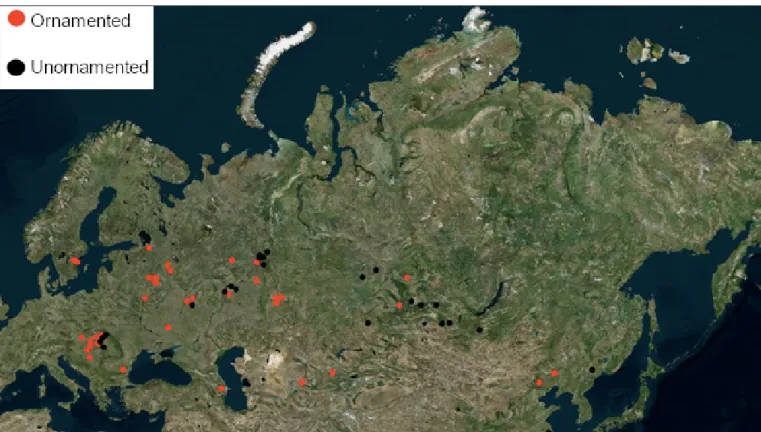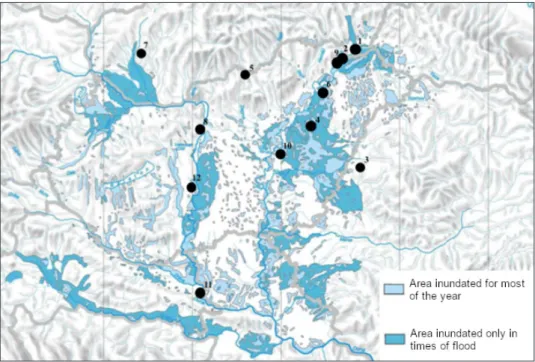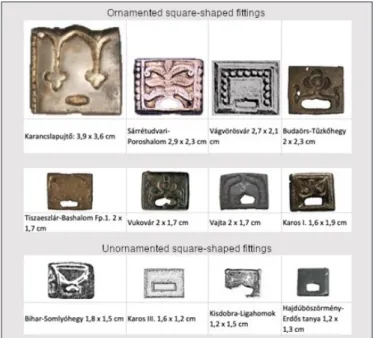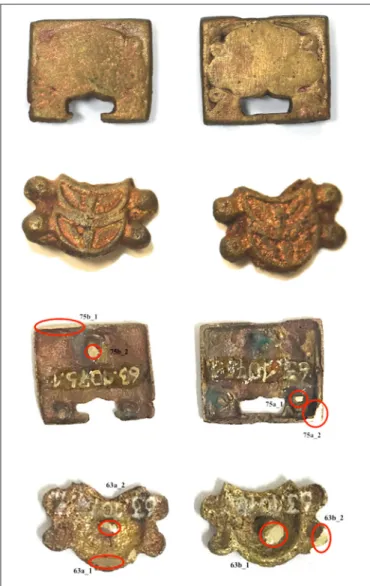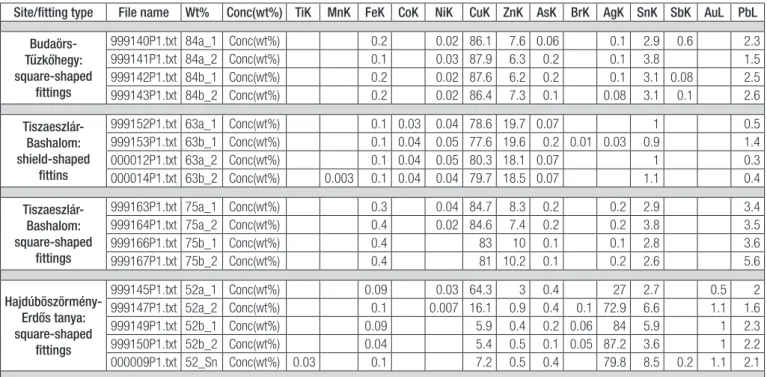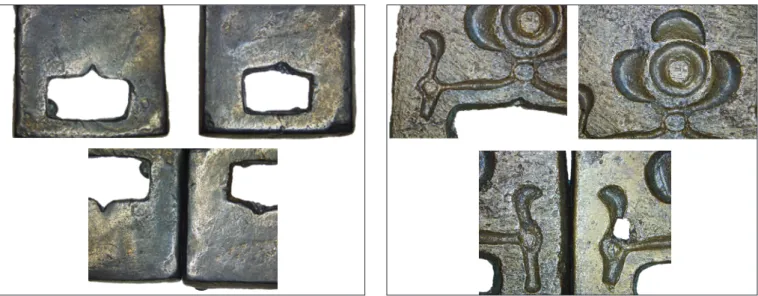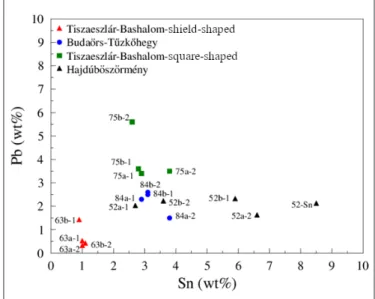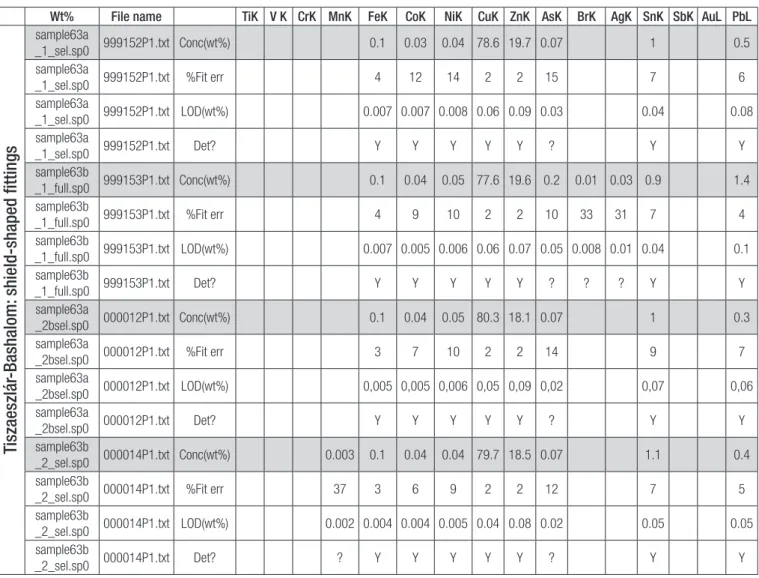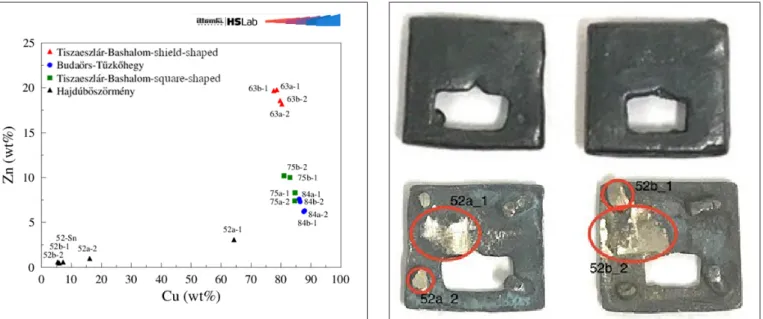SQUARE-SHAPED BELT FITTINGS FROM THE 10TH CENTURY IN THE CARPATHIAN BASIN
Archaeological and archaeometric analysis
AndreA Ilés-MuszkA1– AnIkó AngyAl2
Hungarian Archaeology Vol. 10 (2021), Issue 2, pp. 24‒37. https://doi.org/10.36338/ha.2021.2.2
When analysing archaeological finds, some questions cannot be answered using traditional archaeolog- ical methods, therefore the involvement of the natural sciences is extremely important when examining certain types of objects. Thanks to modern technologies, the relationship between workshops and objects in different remote areas can also be explored. Decorated and undecorated square-shaped belt fittings, which are rare amongst the 10th-century relics of the Carpathian Basin, can be traced back to the Altai region. The castings that can be connected to the first generation of conquering Hungarians are very diverse. Every single one of them is unique in terms of size, materials, and ornamentation. The study below reports the new material analyses of the square fittings of Tiszaeszlár–Bashalom, Budaörs–Tűzkőhegy, and Hajdúböszörmény–Erdős tanya, comparing them to the metal composition of foreign analogies.
Keywords: belt fittings, square-shaped fittings, cast bronze, metal alloy, 10th century, Carpathian Basin, Hungarian Conquest Period, archaeometry, PIXE
SUMMARY OF RESEARCH HISTORY
The complete archaeological processing of square belt fittings in the Carpathian Basin did not take place for a long time. In the Hungarian literature, they were given only a footnote or a brief mention.
1 Department of Archaeology, University of Szeged. E-mail: ilesandrea67@gmail.com
2 Institute for Nuclear Research (ATOMKI), Debrecen, Hungary. E-mail: angyal.aniko@atomki.hu
Fig. 1. Map of the distribution of decorated and undecorated square fittings, supplemented with the latest sites (Following Schulze-Dörlamm 1988, 384.)
The very first square-shaped belt fitting was found in 1899 in Kisdobra–Ligahomok. At that time, the archaeologist who excavated and published it, Gyula Dókus, recognized its archaic nature and made an analogy with Russian examples (Dókus 1900). Ist- ván Fodor (FoDor 1980, 18, footnote 6) and Mecht- hild Schulze-Dörlamm (schulze-Dörlamm 1988, 385–387, 454–455) dealt more thoroughly with the origins of the fittings and the description of their parallels. Their distribution is evidenced from the Carpathian Basin through Scandinavia to China and Korea (Fig. 1).
Mechthild Schulze-Dörlamm and Károly Mes- terházy (mesterházy 1989–1990) studied the fit- tings’ chronological classification in the late 1980s.
In their opinion, this type of casting could only have arrived in the Carpathian Basin with the first genera- tion of Hungarians. They had access to these belt sets, which were presumably made by the people of North-Eastern Europe, while living in the Etelköz region. Most Hungarian researchers agree with this idea even today.
László Révész touched upon the square-shaped fittings when he published his findings from the cemeter- ies of Karos (révész 1996, 105–106, footnotes 432 and 433). In addition to the list of sites, he drew atten- tion to the possible secondary use of the fittings from Bihar–Somlyóhegy. He also rejected the definition of the objects of Karos III/11, Hajdúböszörmény–Erdős tanya and Kisdobra–Ligahomok as belt fittings, instead identifying them as fittings for quiver straps (révész 1996, 35–36, 105–106, footnotes 432 and 433, Pl. 1.20–21; Pl. 120.20–22).
He also listed some silver fittings from Zsombó–Bába- dűlő, however these finds cannot be included in the group of square-shaped fit- tings, as they are completely dissimilar from the afore- mentioned examples (langó 2007, 232, footnote 105).
Later, the specimens of Léva-Génye from Slovakia were also incorrectly clas- sified in this group, but this type differs from the exam- ined examples both in terms of shape and technical design (nevizánszky 2005, 186, Pl.
6.17, 19; ilés-muszka2020).
Research gained new impetus when a set of square- shaped belt fittings was found in Scandinavia that were analogous to those in the Car-
Fig. 2. Parallels of square and rectangular belt fittings
Fig. 3. Square belt fitting from Vajta. Photograph by László Schilling (Hungarian National Museum Archaeological Heritage Protection Directorate) 1: Kisdobra–
Ligahomok/Dobrá (Slovakia); 2: Karos I; 3: Bihar-Somlyóhegy/Biharia (Romania);
4: Hajdúböszörmény–Erdős tanya; 5: Karancslapujtő; 6: Tiszaeszlár–Bashalom- Fenyvespart I.; 7: Vágvörösvár/Červeník (Slovakia); 8: Budaörs–Tűzkőhegy, Naphegy
utca; 9: Karos III; 10: Sárrétudvari–Poroshalom; 11: Vukovár-Lijeva Bara (Croatia);
12: Vajta, Nyilaki-dűlő III.
pathian Basin. This brought along the complete pro- cessing, classification, and examination of the objects and their parallels in the Carpathian Basin (Fig. 2).
These results were published in my earlier papers (ilés-muszka 2018; 2019). In my studies, I have examined several types of objects, burial customs, and warfare strategies through traditional archaeo- logical methods. I have come to the conclusion that possible evidence of a relationship between the two geographic areas can be found among weapons that differ from those used generally in the northern type of warfare, including archery accessories and their ornaments, rather than among the sets of widespread belt fittings (ilés-muszka 2019, 2020).
After László Révész published his findings, another set of belt fittings was uncovered in the cem- etery of Vukovar–Lijeva bara in Croatia, and these show a great resemblance to the examples found in Budaörs–Tűzkőhegy (Figs 2–4) (Demo 2009, 78–79).
Similar fittings are known from the Permian region of Russia and the northeastern part of Bulgaria, as well as from the southern Ural region (murasheva 2000, 44, fig. 59, 1; Pletnjov & Pavlava 1994–1995, 25–26, 193).
Last year the number of known square fittings increased due to a discovery in Vajta. In 2019, surveys using metal detectors found traces of a grave from the Hungarian Conquest period near Vajta. A verifica- tion excavation was carried out at Vajta, Nyilaki-dűlő III in the autumn of 2020 by the archeologists of the Hungarian National Museum, excavating the entire female grave and its surroundings. The aforementioned square bronze belt fitting was discovered as a stray find, and may have been from the grave of a man. The ornamentation of the bronze fitting is also unique, and does not resemble any previously unearthed pieces.
Its slot, which also functions as an ornament, culminates in a large arc, similarly to the undecorated piece form Kisdobra. Its surface is very worn, but it is still clear that its two sides were once framed by rows of circles with a break in the middle. The Vágvörösvár fitting has a similar border, but there the spherical border decoration only runs along the upper part of the fitting. The motif on the inner side of the Vajta example is somewhat similar to a fitting found in Sarkel, but I did not find any direct parallels with these foreign pieces. Due to its size (which is simi- lar to the examples from Budaörs–Tűzkőhegy and Tiszaeszlár–Bashalom-Fenyvespart I), it presum- ably decorated a belt (Fig. 5).3
PREVALENCE OF SQUARE FITTINGS
Square-shaped belt fittings are common in the ancient Mordovian and Cheremis cemeteries in the Volga region. They can also be found in the late Lomovatovo burials along the Kama in the South Ural region, in addition to in the tombs of the ancient Cheptsa valleys during the 9th–10th centuries in Bashkiria as well
3 As this is still an ongoing excavation, I would like to thank László Révész and Rita Soós (Hungarian National Museum) for their information about the work and the finds, as well as László Schilling (Hungarian National Museum, Archaeological Heritage Protection Directorate) for the photographic documentation of the belt fitting.
Fig. 4. Distribution of square and rectangular belt fittings in the Carpathian Basin
Fig. 5. The square-shaped fitting from Vajta. Photo by László Schilling (Archaeological Heritage Protection Directorate,
Hungarian National Museum)
as along the upper section of the Volga, in the 10th–11th centuries. However, square-shaped fittings are considered rare in the region of the Saltovo culture, and in the Volga-Kama region in the 8th–10th centuries (FoDor 1980, 18, note 6). In terms of the number of foreign parallels, this is a very widespread belt type over a large area, but it had become a rarity by the time it reached the Carpathian Basin (Fig. 1). Thus far, only 12 sites are known to contain them, including the most recently found examples from Vukovar and Vajta. Most of the fittings are grouped in the northern and north-eastern part of the Carpathian Basin, as well as in the Bihar area. Square fittings are represented by only one site each in Transdanubia and in the south- ern part of the region (Fig. 3). These rare fittings from the beginning of the 10th century in the Carpathian Basin are all extremely varied in terms of their material, ornamentation, and even their sizes (Fig. 4).
The majority of the burials in the Carpathian Basin that yielded square-shaped belt fittings were the graves of armed warriors and leaders. The dating of these burials is aided by objects with archaic decora- tions and eastern parallels, as well as coins occasionally found in the tombs.
HAJDÚBÖSZÖRMÉNY–ERDŐS TANYA
The excavation at Hajdúböszörmény–Erdős tanya began in September 1926, under the leadership of János Szőregi and Péter Fekete Halasi. Along with Avar burials, a grave of a man from the Hungarian Conquest period was unearthed.
The deceased was buried 130 cm deep in an extended supine position with NW-SE orientation. The bones of a horse, the bit, and the stirrups were laid on the left side of the deceased. The grave goods included a sabre, the bone plates covering the grip of a reflex bow, quiver remains, arrowheads, knives, and an iron axe. The metal ornaments on the shroud included a square- and a shield-shaped gold plate with a broken edge, and a thin-cast heart-shaped silver fitting.
No belt buckles or belt ends were found in the grave, only the heart-shaped pieces attached to the shroud and two pieces of unadorned square-shaped fittings were found. One was located next to the left elbow and the other lay between the horse skull and the left knee. Their dimensions were 1.2×1.3 cm and 1.3×1.4 cm, and they had four rivets on the back for mounting. Their function cannot be determined precisely, but the fittings probably belonged to the strap of a quiver (kovács 1983, 25, révész 1996, 106). Eastern European analogies of this are known from countless sites (FoDor 1980, 18, note 6; murasheva 2000).
TISZAESZLÁR–BASHALOM-FENYVESPART I, GRAVE B/9
József Rohács found the first graves in Fenyvespart to the north of the village of Bashalom, and these were dated to the Hungarian Conquest period. He then excavated 22 graves under the supervision of archaeol- ogist Lajos Kiss. In 1948, Mihály Párducz and Nándor Fettich found two more graves, only one of which they excavated, while István Dienes excavated the other in 1958 during his survey of the Fenyvespart II cemetery (tóth 2014). The cemetery consisted of one long and two shorter rows of graves that contained the bodies of eight men, four women, six children, and six persons of indeterminate sex. The cemetery is rich in grave goods that include insignias of rank, weapons, armed warriors buried with their horses, and jewelry. Their wives and children were also buried next to them. Some of the graves had been robbed.
The body of the man in grave B/9 in the middle of the row was laid in an extended supine position with a W-E orientation. Traces of two trepanations were observed on the skull of this 23-25 -year-old man. Horse bones, stirrups, and a bit were found on the left side of the deceased. Fragments of a silver-plated shroud, arrowheads, quiver remains, a caftan button, and weapon belt assemblies were found in the tomb. The belt was improperly placed in the grave, detached, and laid crosswise on the chest. The set included 30 square- shaped bronze fittings pierced at the bottom, as well as 50 double crescent (or split shield) shaped, flake- patterned castings with two bumps on each side. The set also included three cast bronze strap ends and a heart-shaped buckle. The fittings are heavily worn, but the surface of the rectangular ones have a slightly embossed palmette decoration with no known direct parallel. Eastern analogies to the crescent-shaped examples are known from several sites, including tombs 7 and 17 of Bolshie Tigani, the Subbotsi burials,
the Uyelgi area, the southern Uralic kurgan buri- als, and the Volga-Bulgarian areas. However, these examples did not have a double but a single cres- cent shape with no embellishment on the surface, only bumps on their sides. Interlocking fittings such as these were usually located on the hanging part of the belt (chalikova & chalikov 1981, 19, 29;
ilés-muszka 2018, 42). In sets of fittings that con- sist of two mount types, like that from Bashalom, the square-shaped fittings are often found together with heart-, crescent-, or shield-shaped ones. The sets from Vágvörösvár, Sárrétudvar and Birka are examples (Figs 4 and 6).
BUDAÖRS–TŰZKŐHEGY, NAPHEGY UTCA A grave dated to the Hungarian Conquest period was disturbed during farming in the 1980s and Gáspár Berecz brought these finds to the Budapest History Museum in 1984. The excavation was carried out by Katalin Melis Irásné, who borught to light the disturbed grave and another burial.
In tomb 1, the deceased was a man, in an extended supine position, oriented NW-SE. The grave goods included a sabre, a belt set, arrowheads, a quiver, strap crossings, a knife, and a flint stone. The set of belt fittings included a lyre-shaped cast bronze buckle, twelve palmette-shaped and seven heart- shaped bronze fittings, as well as two square-shaped bronze fittings with rectangular slots at the bottom.
Four 3-mm-long, hammered rivets were used on the
back of the fittings for fastening. The square fitting is adorned with a trifurcate plant motif. The two stems grow from a tiny spherical shape above the slot. The stylized plant adorning the central part of the piece has three petals enclosing the round centre of the flower. The upper part of the rectangular slot on it peaks only slightly and is not even incorporated into the motif. The decoration here is not embossed in the usual way, but the lines have been deepened, which is considered very rare in this era (i. melis 1992, 95–107). I did not find any direct parallels in the Carpathian Basin as I mentioned before, but the one from Vukovar is similar as are some from Russia and Bulgaria (Fig. 2).
ARCHAEOMETRIC ANALYSIS OF THE BELT FITTINGS FROM TISZAESZLÁR–BASHALOM, BUDAÖRS–TŰZKŐHEGY AND HAJDÚBÖSZÖRMÉNY–ERDŐS TANYA
Regarding the square-shaped fittings in the Carpathian Basin, so far only the examples from Karancslapujtő have been examined. Their direct parallels can be found in Russia, where the fittings from Krjukovo–Kuzh- novo and Minyino have also been analysed. Despite the similarity of their motifs and shapes, the studies showed that the material composition of the belt components is quite different, as are their manufacturing techniques, and therefore they cannot be associated with the same workshop (zelencova, saPrykina &
türk 2018, 689–720).
Among the other foreign parallels of the square fittings, the metal composition of the aforementioned examples from Birka (Sweden) and Gnezdovo (Russia) have also been examined. In the area of the Birka
Fig. 6. Measurement points on the fittings from Tiszaeszlár–Bashalom
garrison, to the west of the blacksmith’s workshop, sixteen square- and nine shield-shaped belt fittings were found (Fig. 7). During the material analysis of the pieces, five square- and three shield-shaped examples were analysed (Fig. 8). The objects were examined with a scanning electron microscope equipped with an energy dispersive spectrometer (SEM – EDS). The results show that the plating on the surface of some of the square fittings is mostly tin with a low level of copper, and the underlying layer has a high copper and low tin content with traces of silicon, aluminium, iron, phosphorus, and magnesium. In the case of the shield-shaped fittings, the base of the plating is copper with a small amount of tin, and the components of the lower layers are also cop- per, tin, silicon, aluminium, iron, phosphorus, magnesium, and traces of arsenic (Fig. 9). The researchers concluded that the belt had tin-plated
bronze fittings with the same material composition and manufacturing techniques as the Gnezdovo speci- mens, and so were presumably made in the same workshop (heDenstierna-jonson & holmquist 2006, 13, 86–87).
I have already mentioned in the section about research history that Swedish researchers and also myself have investigated the potential connections between the Carpathian Basin and Scandinavia when the arte- facts from the Birka garrison came to light. I argued that square-shaped fittings cannot be interpreted as evidence for the connections between these regions. These artefacts are not specific to any ethnic group, and they became widespread simply because the elite of the period preferred wearing this type of belt fittings, so they appeared as fashion objects in various regions (ilés-muszka 2020, 31). Regardless, I thought it was important to conduct a proper material analysis of these artefact and to compare them to the Birka finds, as these results have the potential to reveal additional information in terms of the raw material and the tech- nique used. As it is evident in the case of Krjukovo-Kuzhnovo, Birka and Gnezdovo, such investigations may prove or refute certain hypotheses.
The selection of the finds to be examined was an important consideration so that the size, ornamenta- tion, and materials of the fittings would be similar to those of the examples from Birka and Gnezdovo (and therefore they are not comparable to the gold-plated silver fittings of Karancslapujtő). Accordingly,
Fig. 7. Square- and shield-shaped belt fittings from the Birka garrison
Fig. 8. Material test results of the square- and shield-shaped fittings
Site/fitting type File name Wt% Conc(wt%) TiK MnK FeK CoK NiK CuK ZnK AsK BrK AgK SnK SbK AuL PbL Budaörs-
Tűzkőhegy:
square-shaped fittings
999140P1.txt 84a_1 Conc(wt%) 0.2 0.02 86.1 7.6 0.06 0.1 2.9 0.6 2.3
999141P1.txt 84a_2 Conc(wt%) 0.1 0.03 87.9 6.3 0.2 0.1 3.8 1.5
999142P1.txt 84b_1 Conc(wt%) 0.2 0.02 87.6 6.2 0.2 0.1 3.1 0.08 2.5
999143P1.txt 84b_2 Conc(wt%) 0.2 0.02 86.4 7.3 0.1 0.08 3.1 0.1 2.6
Tiszaeszlár- Bashalom:
shield-shaped fittins
999152P1.txt 63a_1 Conc(wt%) 0.1 0.03 0.04 78.6 19.7 0.07 1 0.5
999153P1.txt 63b_1 Conc(wt%) 0.1 0.04 0.05 77.6 19.6 0.2 0.01 0.03 0.9 1.4
000012P1.txt 63a_2 Conc(wt%) 0.1 0.04 0.05 80.3 18.1 0.07 1 0.3
000014P1.txt 63b_2 Conc(wt%) 0.003 0.1 0.04 0.04 79.7 18.5 0.07 1.1 0.4
Tiszaeszlár- Bashalom:
square-shaped fittings
999163P1.txt 75a_1 Conc(wt%) 0.3 0.04 84.7 8.3 0.2 0.2 2.9 3.4
999164P1.txt 75a_2 Conc(wt%) 0.4 0.02 84.6 7.4 0.2 0.2 3.8 3.5
999166P1.txt 75b_1 Conc(wt%) 0.4 83 10 0.1 0.1 2.8 3.6
999167P1.txt 75b_2 Conc(wt%) 0.4 81 10.2 0.1 0.2 2.6 5.6
Hajdúböszörmény- Erdős tanya:
square-shaped fittings
999145P1.txt 52a_1 Conc(wt%) 0.09 0.03 64.3 3 0.4 27 2.7 0.5 2
999147P1.txt 52a_2 Conc(wt%) 0.1 0.007 16.1 0.9 0.4 0.1 72.9 6.6 1.1 1.6
999149P1.txt 52b_1 Conc(wt%) 0.09 5.9 0.4 0.2 0.06 84 5.9 1 2.3
999150P1.txt 52b_2 Conc(wt%) 0.04 5.4 0.5 0.1 0.05 87.2 3.6 1 2.2
000009P1.txt 52_Sn Conc(wt%) 0.03 0.1 7.2 0.5 0.4 79.8 8.5 0.2 1.1 2.1
the square-shaped bronze fit- tings from Budaörs–Tűzkő- hegy, Vu kovar and Tiszaesz- lár–Bas halom were chosen, with the addition of two more shield-shaped fittings from Tiszaeszlár to the list. Unfor- tunately, the analysis of the Vukovar specimens could not be performed, and instead there was an opportunity to examine the silver fittings from the Hajdúböszörmény–
Erdős tanya.
The archaeometric exam- ination of the fittings begun in the spring of 2019 at the Nuclear Research Institute of the Hungarian Academy of Sciences in Debrecen (ATOMKI). Two examples each of bronze square- and shield-shaped fittings from Tiszaeszlár–Bashalom were
analysed, along with the bronze fittings from Budaörs–Tűzkőhegy and the unadorned silver pieces found in Hajdúböszörmény–Erdős tanya.
The work was led by Dr. Thomas Koch Waldner and Dr. Anikó Angyal and measurements were performed by the team of the ATOMKI Ion Beam Applications Laboratory. The preliminary evalua- tion of the results and the description of the methods were provided by Dr. Anikó Angyal.
Fig. 9. Material test results of the Birka square fittings
Fig. 10. Details of the Tiszaeszlár–Bashalom fittings
Fig. 11. Details of the Hajdúböszörmény–Erdős tanya fittings Fig. 12. Details of the Budaörs–Tűzkőhegy fittings Sample Cu (%) Sn(%) Mg (%) Al (%) Si (%) P (%) Fe (%) As (%)
14222a 15 79 - 3 only traces 2 1 only traces
14222b 95 1 - 2 only traces 2 only traces only traces
14222c 59 30 - only traces 3 5 only traces 3
14220a 16 64 only traces 8 2 8 2 only traces
14220b 83 5 2 2 2 6 only traces only traces
14220c 51 8 only traces 4 31 5 only traces 1
14043a - - - - - - - -
14043b 88 5 - 2 5 only traces - only traces
14043c 33 30 - 11 11 13 - 2
14453a 3 87 only traces 5 1 3 1 -
14453b 90 1 only traces 1 only traces 2 6 -
14453c 43 40 2 5 2 4 3 -
14044a 7 83 only traces 7 only traces 3 only traces -
14044b 90 2 1 2 3 2 only traces -
14044c 50 35 only traces 5 4 6 1 -
14221b 92 4 - - 1 1 - -
14225a 38 54 only traces 2 2 2 2 -
14255b 77 14 only traces 1 5 2 1 -
14225c 28 45 1 3 15 7 - -
12748b 70 22 - 6 2 - - -
I performed the preliminary microscopic examination of the fittings myself. It appeared that the square- and the shield-shaped fittings from Tiszaeszlár–Bashalom had different surfaces and colours, so it seemed that they were not made of the same metal alloy. On the worn surface of the fittings, the motif was some- what more noticeable, thus confirming their resemblance to the Poroshalom heart-shaped fittings. On the surface of the silver fittings of Hajdúböszörmény, a
coating similar to a gold and silver coloured glitter powder was observed in some places (Figs 10–12).
Following the microscopic analysis, 17 meas- urement points were examined using the Particle Induced X-ray Emission (PIXE) non-destructive analytical method. Based on the element maps, a homogeneous area was selected at each measure- ment point.
In the case of the Tiszaeszlár-Bashalom shield (18.1–19.7%) and square (7.4–10.2%) fittings, the zinc concentration showed a significant difference.
Based on the lead-tin diagram, a higher lead concen- tration was measured at sampling point 63-b, which was also detected on the element map (Fig. 13). Based
on this diagram, the shield and the square fittings form Fig. 13. The Pb-Sn diagram of bronze and silver objects
Fig. 14. Material test results of the square-shaped fittings from Tiszaeszlár–Bashalom
Wt% File name TiK V K CrK MnK FeK CoK NiK CuK ZnK AsK BrK AgK SnK SbK AuL PbL
Tiszaeszlár-Bashalom: square-shaped fittings
sample75a
_1_sel.sp0 999163P1.txt Conc(wt%) 0.3 0,04 84,7 8,3 0,2 0,2 2,9 3,4
sample75a
_1_sel.sp0 999163P1.txt %Fit err 3 15 2 3 14 18 5 3
sample75a
_1_sel.sp0 999163P1.txt LOD(wt%) 0.007 0.008 0.04 0.07 0.1 0.03 0.07 0.1
sample75a
_1_sel.sp0 999163P1.txt Det? Y Y Y Y ? Y Y Y
sample75a
_2_full.sp0 999164P1.txt Conc(wt%) 0.4 0.02 84.6 7.4 0.2 0.2 3.8 3.5
sample75a
_2_full.sp0 999164P1.txt %Fit err 3 30 2 3 13 13 4 2
sample75a
_2_full.sp0 999164P1.txt LOD(wt%) 0.007 0.009 0.04 0.07 0.09 0.02 0.1 0.1
sample75a
_2_full.sp0 999164P1.txt Det? Y ? Y Y ? Y Y Y
sample75b
_1_sel.sp0 999166P1.txt Conc(wt%) 0.4 83 10 0.1 0.1 2.8 3.6
sample75b
_1_sel.sp0 999166P1.txt %Fit err 2 2 2 21 20 5 3
sample75b
_1_sel.sp0 999166P1.txt LOD(wt%) 0.008 0.008 0.07 0.1 0.03 0.09 0.1
sample75b
_1_sel.sp0 999166P1.txt Det? Y Y Y ? Y Y Y
sample75b
_2_full.sp0 999167P1.txt Conc(wt%) 0.4 81 10.2 0.1 0.2 2.6 5.6
sample75b
_2_full.sp0 999167P1.txt %Fit err 3 2 2 17 16 5 2
sample75b
_2_full.sp0 999167P1.txt LOD(wt%) 0.008 0.03 0.06 0.1 0.02 0.06 0.1
sample75b
_2_full.sp0 999167P1.txt Det? Y Y Y ? Y Y Y
Fig. 15. Material test results of the shield-shaped fittings from Tiszaeszlár–Bashalom
Wt% File name TiK V K CrK MnK FeK CoK NiK CuK ZnK AsK BrK AgK SnK SbK AuL PbL
Tiszaeszlár-Bashalom: shield-shaped fittings
sample63a
_1_sel.sp0 999152P1.txt Conc(wt%) 0.1 0.03 0.04 78.6 19.7 0.07 1 0.5
sample63a
_1_sel.sp0 999152P1.txt %Fit err 4 12 14 2 2 15 7 6
sample63a
_1_sel.sp0 999152P1.txt LOD(wt%) 0.007 0.007 0.008 0.06 0.09 0.03 0.04 0.08
sample63a
_1_sel.sp0 999152P1.txt Det? Y Y Y Y Y ? Y Y
sample63b
_1_full.sp0 999153P1.txt Conc(wt%) 0.1 0.04 0.05 77.6 19.6 0.2 0.01 0.03 0.9 1.4
sample63b
_1_full.sp0 999153P1.txt %Fit err 4 9 10 2 2 10 33 31 7 4
sample63b
_1_full.sp0 999153P1.txt LOD(wt%) 0.007 0.005 0.006 0.06 0.07 0.05 0.008 0.01 0.04 0.1 sample63b
_1_full.sp0 999153P1.txt Det? Y Y Y Y Y ? ? ? Y Y
sample63a
_2bsel.sp0 000012P1.txt Conc(wt%) 0.1 0.04 0.05 80.3 18.1 0.07 1 0.3
sample63a
_2bsel.sp0 000012P1.txt %Fit err 3 7 10 2 2 14 9 7
sample63a
_2bsel.sp0 000012P1.txt LOD(wt%) 0,005 0,005 0,006 0,05 0,09 0,02 0,07 0,06
sample63a
_2bsel.sp0 000012P1.txt Det? Y Y Y Y Y ? Y Y
sample63b
_2_sel.sp0 000014P1.txt Conc(wt%) 0.003 0.1 0.04 0.04 79.7 18.5 0.07 1.1 0.4
sample63b
_2_sel.sp0 000014P1.txt %Fit err 37 3 6 9 2 2 12 7 5
sample63b
_2_sel.sp0 000014P1.txt LOD(wt%) 0.002 0.004 0.004 0.005 0.04 0.08 0.02 0.05 0.05
sample63b
_2_sel.sp0 000014P1.txt Det? ? Y Y Y Y Y ? Y Y
Fig. 17. Measurement points on the fittings from Budaörs–
Tűzkőhegy Fig. 16. Pb particles and Cu, Zn, Sn element maps (scanned
area 1×1mm) at sampling point 63b_1
completely separate groups, confirming the preliminary microscopic examinations (Figs 6, 10, 14–16). The Tiszaeszlár square and shield-shaped fittings were not made of the same metal alloy, so they were not derived from a single casting, even though they were part of the same belt.
Fig. 18. Material test results of the square-shaped fittings from Budaörs–Tűzkőhegy
Fig. 19. The Cu-Zn diagram of bronze and silver objects Fig. 20. Measurement points on the fittings from Hajdúböszörmény
Wt% File name TiK V K CrK MnK FeK CoK NiK CuK ZnK AsK BrK AgK SnK SbK AuL PbL
Budaörs-Tűzkőhegy: square-shaped fitting
sample84a
_1_full.sp0 999140P1.txt Conc(wt%) 0.2 0.02 86.1 7.6 0.06 0.1 2.9 0.6 2.3
sample84a
_1_full.sp0 999140P1.txt %Fit err 3 29 2 3 29 16 4 11 3
sample84a
_1_full.sp0 999140P1.txt LOD(wt%) 0.008 0.009 0.04 0.07 0.08 0.02 0.08 0.06 0.07
sample84a
_1_full.sp0 999140P1.txt Det? Y ? Y Y ? Y Y Y Y
sample84a
_2_full.sp0 999141P1.txt Conc(wt%) 0.1 0.03 87.9 6.3 0.2 0.1 3.8 1.5
sample84a
_2_full.sp0 999141P1.txt %Fit err 4 12 2 3 11 15 4 4
sample84a
_2_full.sp0 999141P1.txt LOD(wt%) 0.003 0.006 0.06 0.06 0.06 0.01 0.05 0.1
sample84a
_2_full.sp0 999141P1.txt Det? Y Y Y Y ? Y Y Y
sample84b
_1_full.sp0 999142P1.txt Conc(wt%) 0.2 0.02 87.6 6.2 0.2 0.1 3.1 0.08 2.5
sample84b
_1_full.sp0 999142P1.txt %Fit err 3 26 2 3 12 14 4 43 3
sample84b
_1_full.sp0 999142P1.txt LOD(wt%) 0.007 0.008 0.05 0.06 0.07 0.01 0.04 0.04 0.1
sample84b
_1_full.sp0 999142P1.txt Det? Y ? Y Y ? Y Y ? Y
sample84b
_2_full.sp0 999143P1.txt Conc(wt%) 0.2 0.02 86.4 7.3 0.1 0.08 3.1 0.1 2.6
sample84b
_2_full.sp0 999143P1.txt %Fit err 3 27 3 3 11 18 4 25 3
sample84b
_2_full.sp0 999143P1.txt LOD(wt%) 0.007 0.008 0.05 0.06 0.07 0.01 0.05 0.03 0.08
sample84b
_2_full.sp0 999143P1.txt Det? Y ? Y Y ? Y Y Y Y
Based on the results obtained, the highest copper concentration (~87%) was found in the case of the points measured on the fittings of Budaörs–Tűzkőhegy. No significant difference in the copper and zinc concentrations was observed between the two fittings, and they were certainly made from a single casting (Figs. 12, 17–19).
The silver-copper component differs in the fittings of the Hajdúböszörmény–Erdős tanya. Silver (27%) and higher copper content (64.3) were measured at measurement point 52a_1, while concentrations of 72.9% silver and 16.1% copper were observed in the same fitting at measuring point 52a_2. At points 52b_1 and 52b_2 of the other fitting, silver concentrations of 84% and 87.2% and copper concentrations of 5.9–5.4% were observed. The difference between the two points of the fitting 52a may be due to improper burnishing. Based on the lead-tin diagram, similar lead concentrations were observed at each measurement point, while differing tin concentrations were observed. Due to the observations of the preliminary micro- scopic examinations, the surface area of the fittings was also examined. At 52_Sn, a tin concentration of 8.5% was measured, which may have been caused by the high inhomogeneity of the fitting material. The fittings also contained 1% gold (Figs 11, 20–21).
Fig. 21. Material test results of the square-shaped fittings from Hajdúböszörmény
Wt% File name TiK V K CrK MnK FeK CoK NiK CuK ZnK AsK BrK AgK SnK SbK AuL PbL
Hajdúböszörmény-Erdős tanya: square-shaped fittings
sample52a
_1_sel.sp0 999145P1.txt Conc(wt%) 0.09 0.03 64.3 3 0.4 27 2.7 0.5 2
sample52a
_1_sel.sp0 999145P1.txt %Fit err 10 29 2 3 5 1 5 6 3
sample52a
_1_sel.sp0 999145P1.txt LOD(wt%) 0.01 0.01 0.05 0.03 0.05 0.05 0.2 0.1 0.1
sample52a
_1_sel.sp0 999145P1.txt Det? Y ? Y Y Y Y Y Y Y
sample52a
_2_sel.sp0 999147P1.txt Conc(wt%) 0.1 0.007 16.1 0.9 0.4 0.1 72.9 6.6 1.1 1.6
sample52a
_2_sel.sp0 999147P1.txt %Fit err 7 64 2 5 6 8 1 4 4 3
sample52a
_2_sel.sp0 999147P1.txt LOD(wt%) 0.008 0.007 0.04 0.03 0.05 0.01 0.06 0.5 0.06 0.1 sample52a
_2_sel.sp0 999147P1.txt Det? Y ? Y Y Y Y Y Y Y Y
sample52b
_1_sel.sp0 999149P1.txt Conc(wt%) 0.09 5.9 0.4 0.2 0.06 84 5.9 1 2.3
sample52b
_1_sel.sp0 999149P1.txt %Fit err 9 3 7 9 13 1 5 4 3
sample52b
_1_sel.sp0 999149P1.txt LOD(wt%) 0.009 0.02 0.02 0.06 0.01 0.06 0.5 0.05 0.1
sample52b
_1_sel.sp0 999149P1.txt Det? Y Y Y Y Y Y Y Y Y
sample52b
_2_full.sp0 999150P1.txt Conc(wt%) 0.04 5.4 0.5 0.1 0.05 87.2 3.6 1 2.2
sample52b
_2_full.sp0 999150P1.txt %Fit err 21 3 7 21 17 1 7 4 3
sample52b
_2_full.sp0 999150P1.txt LOD(wt%) 0.01 0.03 0.02 0.06 0.009 0.1 0.6 0.05 0.06
sample52b
_2_full.sp0 999150P1.txt Det? ? Y Y ? Y Y Y Y Y
sample52_full
_Sn.sp0_Ag 000009P1.txt Conc(wt%) 0,03 0.1 7.2 0.5 0.4 79.8 8.5 0.2 1.1 2.1
sample52_full
_Sn.sp0_Ag 000009P1.txt %Fit err 23 6 2 6 6 1 4 32 4 3
sample52_full
_Sn.sp0_Ag 000009P1.txt LOD(wt%) 0,01 0.009 0.02 0.02 0.05 0.05 0.6 0.06 0.05 0.1
sample52_full
_Sn.sp0_Ag 000009P1.txt Det? ? Y Y Y Y Y Y ? Y Y
SUMMARY OF THE STUDY
The main material components of the square fittings of Tiszaeszlár and Budaörs that had previously been considered bronze are copper, zinc, and tin, as well as lead in smaller percentages, along with traces of iron, nickel and arsenic. The Tiszaeszlár shield-shaped fittings contained higher amounts of copper and zinc, a lower percentage of tin and lead, as well as traces of iron, cobalt, nickel, and arsenic. The zinc concentration is responsible for the differing colours of the fittings from Tiszaeszlár. In accordance with this, the more yellow- ish colour of the shield-shaped ones is caused by a zinc content of 18–19%, while the reddish-yellowish hue of the square examples was caused by the lower ratio of zinc (7–10%). The strength of the casting was improved by adding tin. The pale red colour of the Budaörs fittings was due to the lower zinc concentration of 6.2–7.6%.
The Hajdúböszörmény fittings contained a high percentage of silver, less copper, tin, lead and gold, and traces of bromine, nickel and antimony. The reason for the 1% gold content of the fittings is the presence of gold in its elemental state in nature, which remained in a small percentage in the material used for the fittings.
In light of the test results described here, it can be stated that the metal composition of the square fittings in the Carpathian Basin does not match the material composition of the Birka garrison and the Gnezdovo castings, which are tin-plated bronze castings. Their main components are also completely different. The 54–87% tin layer observed on the surface of the Birka fittings was not characteristic of any of the examined fittings from the Carpathian Basin. A tin concentration of only 8.5% was measured at Hajdúböszörmény, which could not be equated with them. Overall, based on the elemental composition of the items, the con- nection with the Birka or Gnezdovo belt fittings has not been proven. However, I do not think that far- reaching conclusions can be drawn from this, as craftspeople could change the material they worked with on a daily basis even within a single workshop.
I consider it important to continue the archaeometric examination of these finds, because as we have seen, some items that seem to be clearly related to belts can cause surprises. The square and shield-shaped fittings of Tiszaeszlár revealed that although they were part of a single set, they were not made from one casting, and their material was not bronze but brass, just like the ones from Budaörs. The surface of the Hajdúböszörmény fittings may have been plated with a thin layer of tin, which, although not as thick as that of the Birka fittings, is still significantly different from the other examples tested. As we have seen, it is worthwhile to expand the database continuously because all of the research results that come in will contribute to the expansion of our knowledge.
reFerences
Cambell, J. L., Hopman, T. L., Maxwell, J. A. & Nejedly, Z. (2000). The Guelph PIXE software package III:
alternative proton database. Nuclear Instruments and Methods in Physics Research B: Beam Interactions with Materials and Atoms 170 (1–2), 193–204. https://doi.org/10.1016/S0168-583X(00)00156-7
Chalikova, E. A. & Chalokov, A. H. (1981). Altungarn and der Kama und im Ural. Das Gräberfeld von Bolschie Tigani. Régészeti Füzetek Ser II. 21. Budapest: Magyar Régészeti Múzeum.
Demo, Ž. (2009). Ranosrednjovjekovno groblje bjelobrdske kulture: Vukovar – Lijeva Bara (X–XI. stoljeće) – An Early Medieval Cemetery of the Bijelo Brdo Culture — Vukovar-Lijeva Bara (10th-11th Century). Musei Archaeologici Zagrabiensis Catalogi et Monographie VI/1-2. Zagreb: Arheološki muzej u Zagrebu 2009.
Dienes, I. (1957). A bashalmi (Szabolcs-Szatmár m.) honfoglaláskori magyar temető [The Hungarian Conquest Period cemetery of Bashalom (Szabolcs-Szatmár County)]. Archeologiai Értesítő 4 (1957), 24–37.
Dókus, Gy. (1900). Árpádkori sírleletek Zemplén vármegyében. (Árpádenzeitliche Grabfunde im Komitat Zemplén.) Archeologiai Értesítő 20 (1900), 39–61.
Fodor, I. (1980). A magyar-bolgár-török kapcsolatok történeti hátteréről [On the historical background of Hungarian-Bulgarian-Turkish relations]. In I. Dankó (ed.), Bolgár tanulmányok III (pp. 9–48). A Hajdú- Bihar Megyei Múzeumok Közleményei 37. Debrecen: Déri Múzeum.
Hedenstierna-Jonson, C. & Holmquist Olausson, L. (2006). The Oriental mounts from Birka’s Garrison. An expression of warrior rank and status). Antikvariskt Arkiv 81, 46–77.
Irásné Melis, K. (1992). Honfoglalás kori leletek Budaörs–Tűzkőhegyről [Hungarian Conquest period finds from Budaörs–Tűzkőhegy]. Budapest Régiségei 29 (1992), 95–107.
Ilés-Muszka, A. (2018). Négyzet alakú övveretek a 10. században. Egy skandináv lelőhelyen előkerült négyzet alakú verettel díszített övfelszerelés és Kárpát-medencei párhuzamai [Square-shaped belt fittings in the 10th century. Analogies of a set of square-shaped belt fittings from Scandinacia in the Carpathian Basin]. MA thesis. University of Szeged 2018.
Ilés-Muszka, A. (2019). A birkai helyőrség Kárpát-medencei kapcsolatai. Előadás a XXXIV. Országos Tudományos Diákköri Konferencián [Hungarian connections of the garrison in Birka. Paper given at the 34th National Conference of Scientific Students’ Associations]. Budapest, 2019. Unpublished manuscript.
Kovács L. (1983). A Hajdúböszörmény–Erdős tanyai honfoglaló magyar sírlelet (Der landnahmezeitliche ungarische Grabfund von Hajdúböszörmény–Erdős tanya. Angaben zur Verbreitung der Hohlbeile in der Awaren. und Landnahmezeit). Hajdúsági Múzeum Évkönyve 5 (1983), 19–53.
Langó, P. (2007). Amit elrejt a föld... A 10. századi magyarság anyagi kultúrájának régészeti kutatása a Kárpát-medencében [What is hidden in the ground… Archaeological research into the material culture of 10th century Hungarians in the Carpathian Basin]. Budapest: L’Harmattan.
Mesterházy, K. (1989–1990). A Felső-Tisza-vidéki ötvösműhely és a honfoglalás kori emlékek időrendje [The goldsmith’s workshop in the Upper Tisza region and the chronology of Hungarian Conquest period finds]. Agria 25–26 (1989–1990), 235–274.
Murasheva, V. V. (Мурашева, В. В.) (2000). Drevnerusskie remennye nabornye ukrashenija (X–XIII. v.v.) (Древнерусские ременные наборные украшения (X–XIII. в.в.)). Moskva: Izdatel’skaja gruppa URSS.
Murasheva, V. & Pushkina, T. (2002). Excavations in Gnezdovo near Smolensk. In G. Helmig, B.
Scholkmann & M. Untermann (eds), Centre – Region – Periphery. Medieval Europe Basel 2002. 3rd International Conference of Medieval and Later Archaeology, Basel (Switzerland) 10–15 (pp. 329–332).
Hertingen: Folio.
M. Nepper, I. (2002). Hajdú-Bihar megye 10–11. századi sírleletei I–II [10th–11th-century grave goods in Hajdú-Bihar County]. Ed. by I. K. Bende. Magyarország honfoglalás kori és kora Árpád-kori sírleletei 3.
Budapest–Debrecen: Déri Múzeum – Magyar Nemzeti Múzeum – MTA Régészeti Intézet.
Nevizánszky, G. (2013). Egy újabb honfoglaláskori temető az Alsó-Garam mentén [A recently discovered Hungarian Conquest period cemetery along the Lower Garam stream]. In: L. Révész & M. Wolf (eds), A honfoglaláskor kutatásának legújabb eredményei. Tanulmányok Kovács László 70. születésnapjára (pp. 185–191). Monográfiák a Szegedi Tudományegyetem Régészeti Tanszékéről 3. Szeged: Szegedi Tudományegyetem Régészeti Tanszék.
Pletnjov, V. & Pavlova V. (1994–1995). Rannosrednovekovni remačni aplikacii vav Varnenskiâ Arheologičeski Muzej (Frühmittelalterliche Riemenbeschläge im Archäologischen Museum von Varna).
INMV 30–31 (1994–1995), 24–191.
Rajta, I., Borbély-Kiss, I., Mórik, G., Bartha, L., Koltay, E. & Kiss, Á. Z. (1996). The new ATOMKI scanning proton microprobe. Nuclear Instruments and Methods in Physics Research B: Beam Interactions with Materials and Atoms 109–110 (1996), 148–153. https://doi.org/10.1016/0168-583X(95)00897-7 Révész, L. (1996). A Karosi honfoglalás kori temetők. Régészeti adatok a Felső-Tisza-vidék X. századi történetéhez [Hungarian Conquest period cemeteries at Karos. Archaeological data on the history of the Upper Tisza region in the 10th century]. Miskolc: Herman Ottó Múzeum – Magyar Nemzeti Múzeum.
Schulze-Dörlamm, M. (1988). Untersuchungen zur Herkunft der Ungarn zum Beginn ihrer Landnahme im Karpatenbecken. Jahrbuch des Römisch-Germanischen Zentralmuseums 35 (1988), 373–478.
Točik, A. (1968). Altmagyarische Gräberfelder in der Südwestslowakei. Archaeologica Slovaca Catalogi III. Bratislava: Akademie der Wissenschaften Bratislava.
Tóth, A. (2014). A Nyíri Mezőség a 10–11. században [The Mezőség area in Nyír in the 10th–11th century].
Magyarország honfoglalás és kora Árpád-kori temetőinek leletanyaga VII. Szeged: Magyar Nemzeti Múzeum.
Zelencova, O. V. ‒ Saprykina, I. A. ‒ Türk A. (2018). A karancslapujtői honfoglalás kori öv és mordvinföldi
„hasonmása”. A karancslapujtői típusú övveretek kelet-európai elterjedése [The belt from Karancslapujtő dated to the Hungarian Conquest period and its “counterpart” in Mordovia. The spread of the Karancslapujtő type of belt fittings in Eastern Europe]. In A. Türk, Cs. Balogh & A. Korom (eds), Relationes rerum – Régészeti tanulmányok Nagy Margit tiszteletére (pp. 689–720). Budapest: Archaeolingua.
